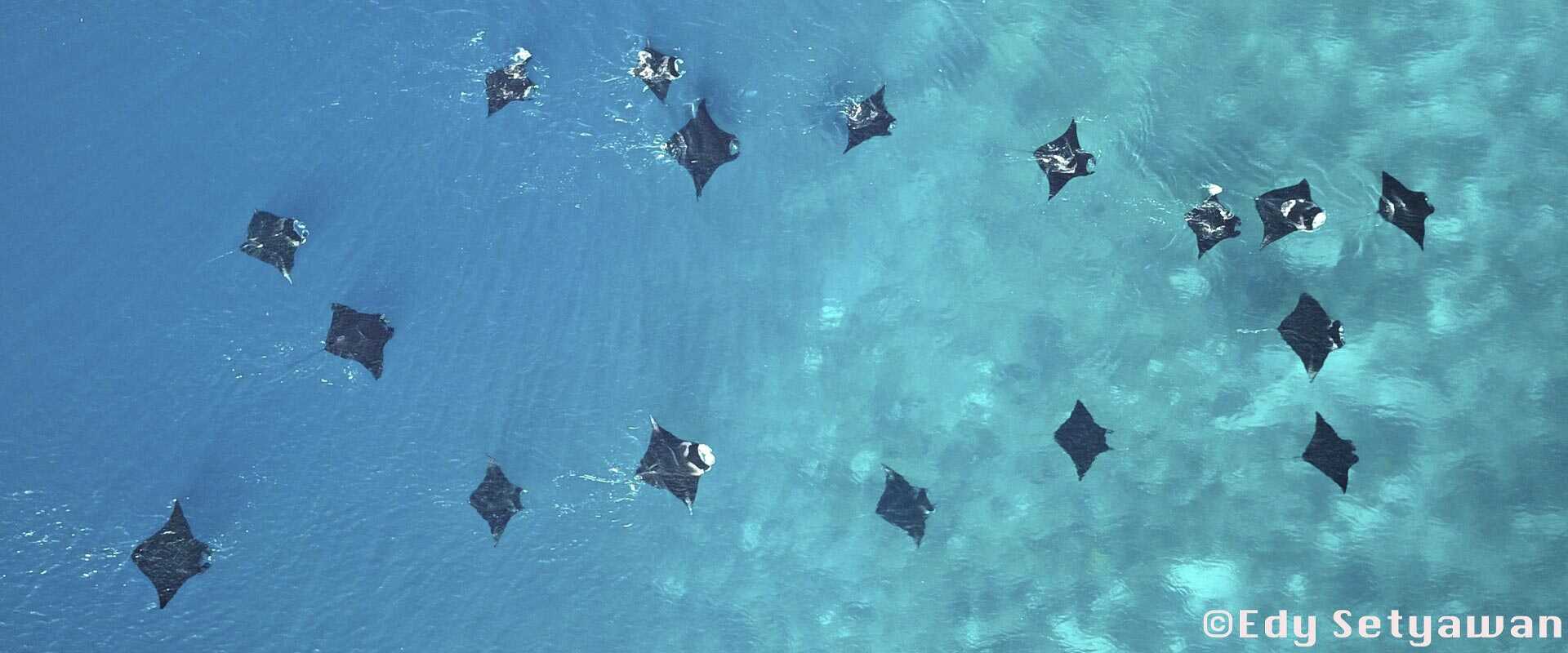Manta Ray Management Workshop by Allan Fredrik Ramandey*
A collaborative workshop to further develop efforts to manage Raja Ampat Manta Rays was recently held in early Decemeber ’21.
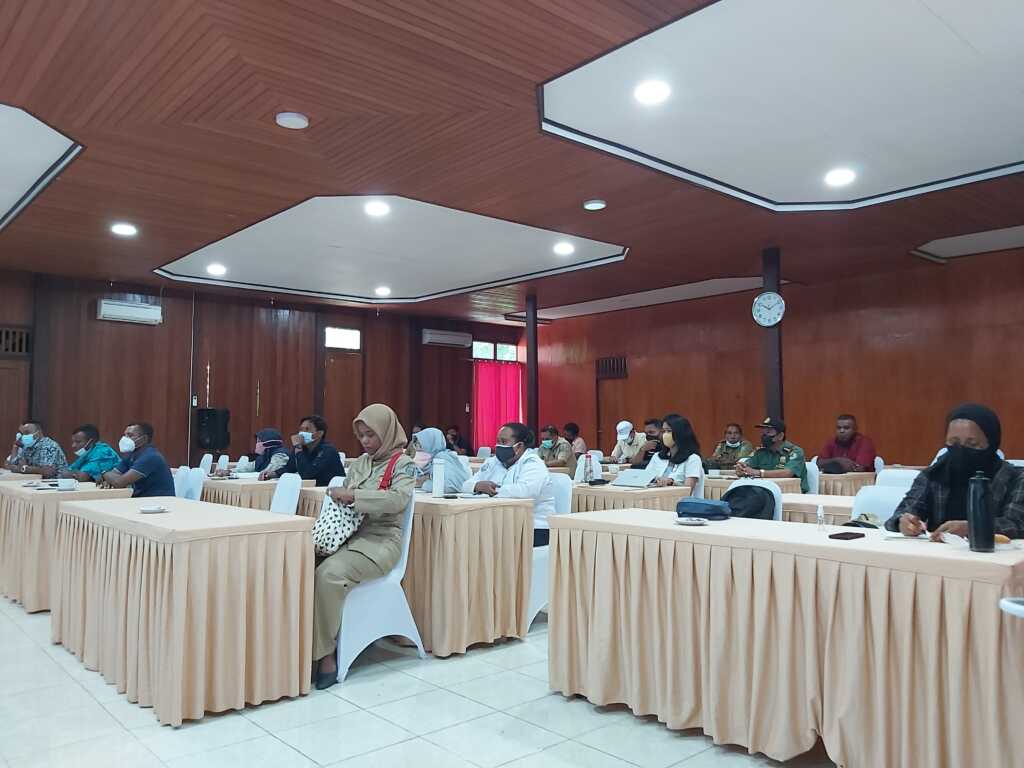
Workshop on manta ray management conducted on the 06th of December in Waisai, Raja Ampat. (Photo by: Allan Fredrik Ramandey-BLUD UPTD Pengelolaan KKP Kepulauan Raja Ampat/2021)
Waisai, Raja Ampat.
Raja Ampat’s seas are blessed with abundant biodiversity due to its marine and coastal ecosystem still being generally intact. Raja Ampat’s waters are a natural habitat for various protected marine fauna; including two species of manta rays – Mobula alfredi and Mobula birostris.
The management approach of Marine Protected Areas (MPAs) in Raja Ampat, was originally outlined in Raja Ampat’s Regulation Number 9, of the Year 2012, which declared the Protection of Sharks, Manta Rays, and Particular Species of Fish in Raja Ampat Waters. This plan has been successful, with certain limitations, to significantly decrease the catch of manta rays in this archipelagic regency.
The positive achievement in fisheries sector have, on the other hand, increased the intensity of potential utilization from another, non-extractive sector: tourism. Raja Ampat’s rapid development as one of the world’s premier marine tourism destinations took off in mid-2000s, but it has presented this region with various challenges; and one of them is the field of manta ray tourism management.
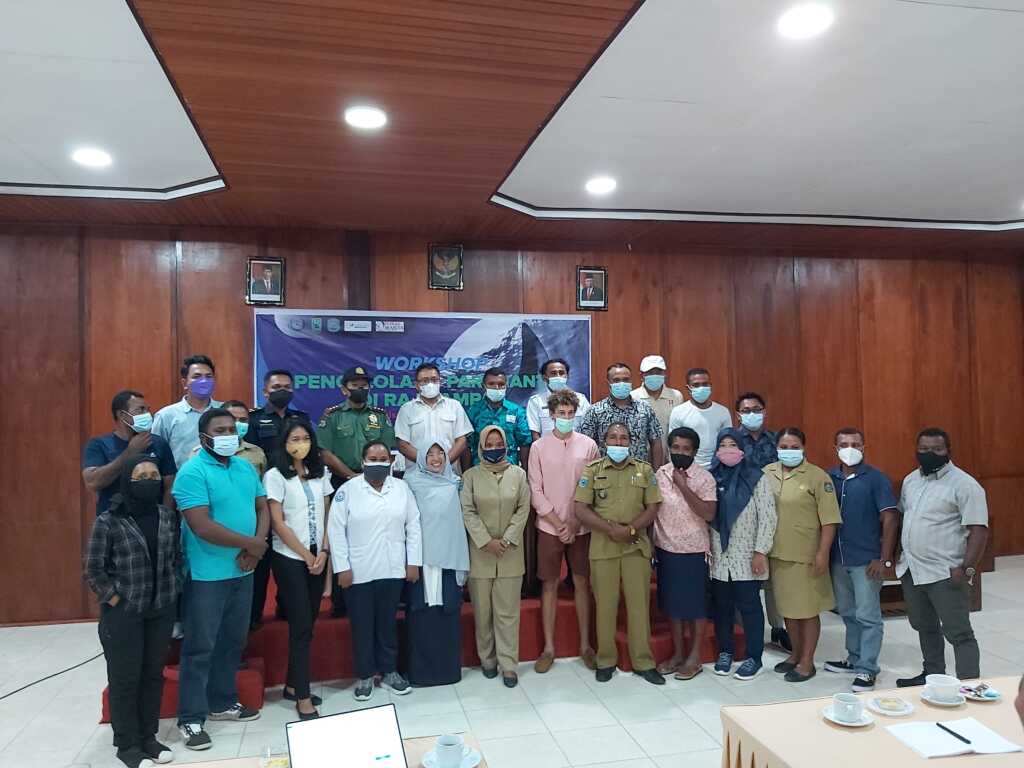
Participants of the workshop took picture subsequent to formalizing results generated from the event that day. The event was attended by 37 participants from 22 government and non-governmental organizations, and private sectors. (Photo by: Allan Fredrik Ramandey-BLUD UPTD Pengelolaan KKP Kepulauan Raja Ampat/2021)
One of the efforts to increase the effectiveness of manta ray management by the Raja Ampat Marine Park’s Authority**, in collaboration with Raja Ampat’s Regency Government and Raja Ampat’s Manta Work Group, was organizing a workshop, which was held on December 6. On the following day socialization continued with manta ray observation by the workshop attendees.
The head of Raja Ampat Marine Park’s Authority, Syafri, S.Pi, stated during his opening speech, “This event is significant for us as MPA managers. Mantas are fully protected in Indonesia and one of the mandates is the protection of the habitat and biota (of manta rays).” He continued, “On the other hand, manta rays have become a target for tourists, (one of the) beneficiaries of the MPAs, and this event aims to design the utilization of manta ray tourism based on carrying capacity.”
Syafri also said, “Regarding manta ray management (in Raja Ampat), (we) encourage all the stakeholders to participate in protecting mantas and safeguarding monitoring efforts by complying to all the rules, and standardizing how socialization can be done. If we move in the same rhythm, speak the same language, do the same action, then Raja Ampat will be stronger and can become a model in manta rays’ management in Indonesia and beyond.”
This workshop also featured a presentation by Edy Setyawan, a scientist who has studied manta rays in Raja Ampat and other locations in Indonesia. “There are many interesting findings from the population study of manta rays in Raja Ampat. One of the unique things is that so many infants and juvenile reef mantas can be found in four identified breeding grounds; three of the four areas are located in Dampier Strait (MPA) and West Waigeo (Islands Marine Reserve).” Edy explained that female mantas in Raja Ampat have a relatively higher fertility rate compared to other populations in Indo-Pacific.
Edy then emphasized, “At minimum, there are three urgent matters that need to be done by the area managers (in Raja Ampat). They are: (1) the management and implementation of special rules to protect the infants and juvenile in their breeding and aggregation grounds located beyond/outside the established conservation areas; (2) managing important and popular aggregation areas, especially in Dampier Strait (MPA), and to; (3) regularly monitor manta ray populations in their aggregation locations, whether through survey or the development of citizen-science programs.”
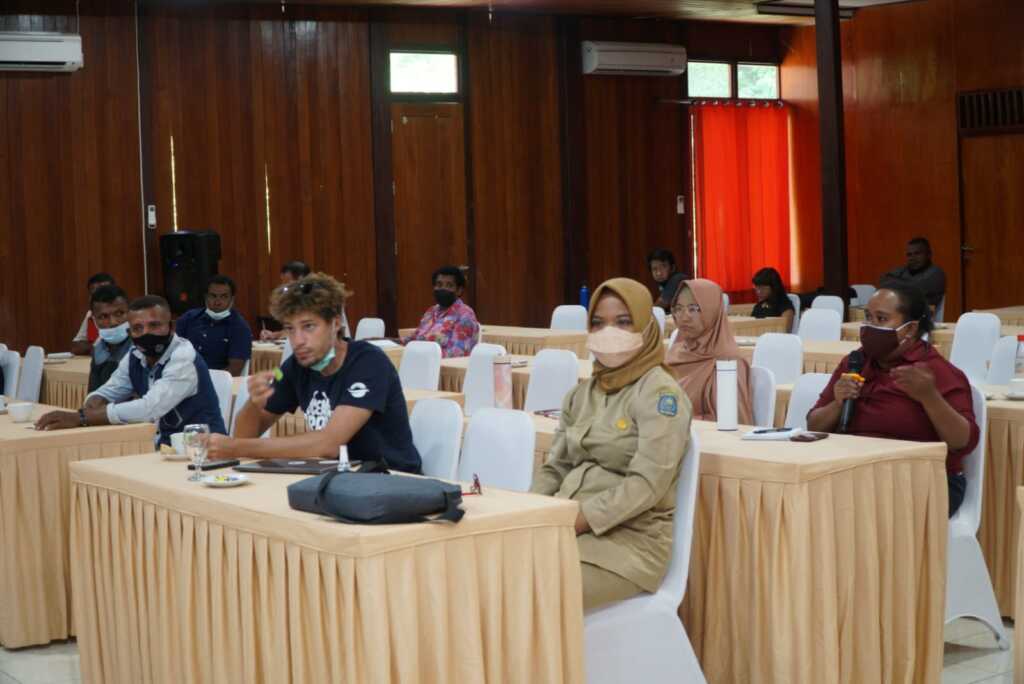
Participants provided conceptual inputs during the citizen-science program socialization event. (Photo by: Allan Fredrik Ramandey-BLUD UPTD Pengelolaan KKP Kepulauan Raja Ampat/2021)
FYI, in 2017, the Regency Government of Raja Ampat, West Papua Province Government’s Raja Ampat Marine Park Authority, and a consortium of manta ray observers in Raja Ampat created a collective named Raja Ampat’s Manta Work Group, which has collaborated in developing a model of responsible, manta ray tourism.
One of the management models manifested in the establishment of the monitoring post at the dive site known as “Manta Sandy”, along with the formation of the Manta Cadre, which consists of representatives from villages near popular dive sites, such as Arborek, Sawinggrai, Kurkapa, and Kapisawar. Operation of Manta Sandy’s Monitoring Post is officially under the management of the Marine Park’s Authority.
The workshop was attended by 37 representatives from a total of 22 government and non-governmental organizations, including the private sector. Beside the Marine Park’s Authority’s program, the workshop featured presentations from the Ministry of Marine and Fisheries’ technical units working for Raja Ampat.
After two discussion sessions, day one was concluded with a plan for follow-ups focusing upon several issues ranging from the extension of Manta Sandy Monitoring Post’s working area to include “Manta Ridge” with consistent application of a reservation system for tourists on both dive sites. And including follow-up socialization events related to dissemination of manta ray population studies in Raja Ampat, and a plan to implement general and technical guidelines on interaction with manta rays during snorkeling and SCUBA Diving.
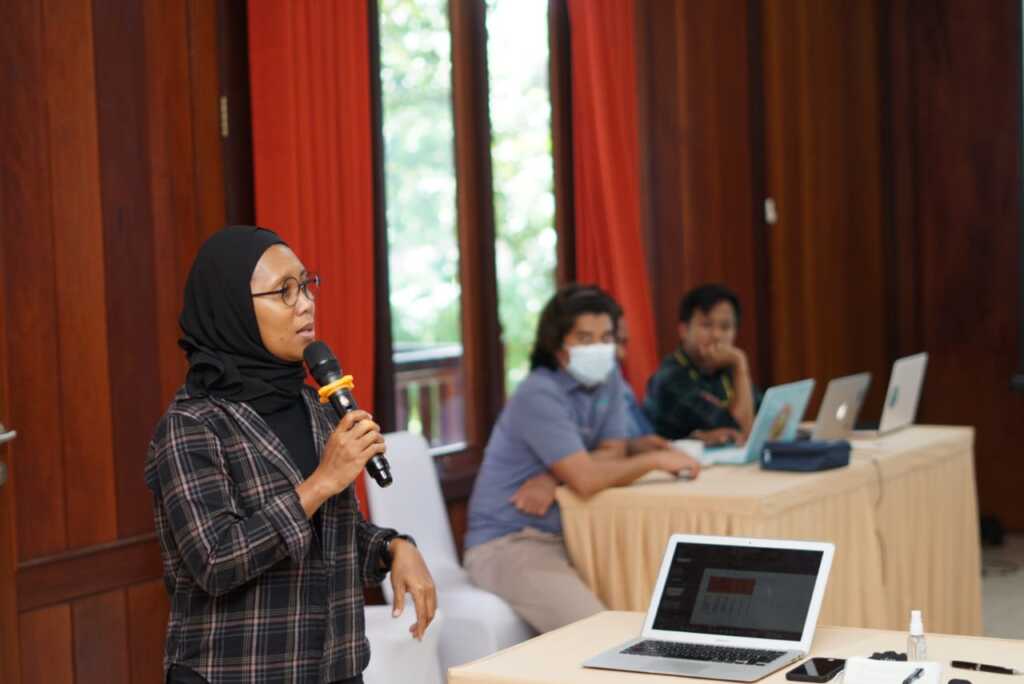
CI Indonesia’s Maulita Sari Hani conveying her opinion during one of the discussion sessions in the workshop on 06th December, 2021. (Photo by: Yakonias Thonak-BLUD UPTD Pengelolaan KKP Kepulauan Raja Ampat/2021)
Maulita Sari Hani, one of participants working for Conservation International (CI) Indonesia as Conservation Socio Economic Specialist, opined, “I hope that management (of manta rays in Raja Ampat) can become a pioneer program for conservation areas, especially of manta species. In Indonesia, area-based tourism management with species’ attraction is predominant, and Raja Ampat can become one, or even the leading destination in managing species conservation-based tourism management. I hope this event can be a reference for other locations regarding management of area-based, species management.”
The next day, 07th of December, 2021, the collaborative event continued with a socialization event titled “Manta Rays Population’s Participative Observation Through Citizen-Science Program.” In a nutshell, this event introduced a participatory method that enables anyone to participate in efforts to monitor the manta ray population in Raja Ampat through a smartphone application.
Wobbegong Dive Shop’s Ruben Sauyai observed that this citizen-science program may be an opportunity for tourists and the industry to actively and collectively participate. He continued, “The reward (from citizen- science programs) might make tourists more enthusiastic in supporting this program, where they can be rewarded, or in a way ‘immortalized’, through naming manta rays, (while for) the tourism industry this program can be included in interesting marketing packages.”
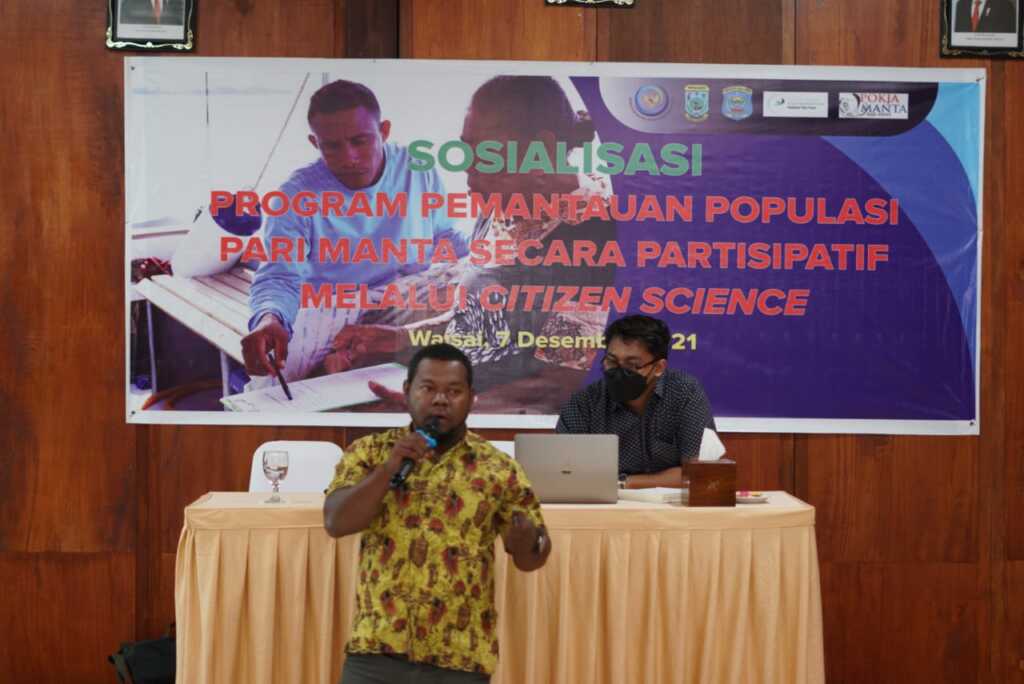
Imanuel Mofu, one of the resource persons in socialization event conducted on the 07th of December, 2021, addressing to the audience regarding the steps of participation in the citizen-science program. (Photo by: Yakonias Thonak-BLUD UPTD Pengelolaan KKP Kepulauan Raja Ampat/2021)
When contacted after the event, Raja Ampat Marine Park Authority’s Monitoring Staff, Imanuel Mofu emphasized, “This program is significant, especially for the locals and tourists. The data collected from citizen-science programs (will further) prove that it is very important for all the stakeholders to protect and manage the manta ray population in Raja Ampat.”
* Allan Fredrik Ramandey is Data and Information Staff for Raja Ampat’s Marine Park Authority.
** The official name for Raja Ampat’s Marine Park Authority is Badan Layanan Umum Daerah Unit Pelaksana Teknis Daerah (BLUD UPTD) Pengelolaan Kawasan Konservasi Perairan (KKP) Kepulauan Raja Ampat.





































